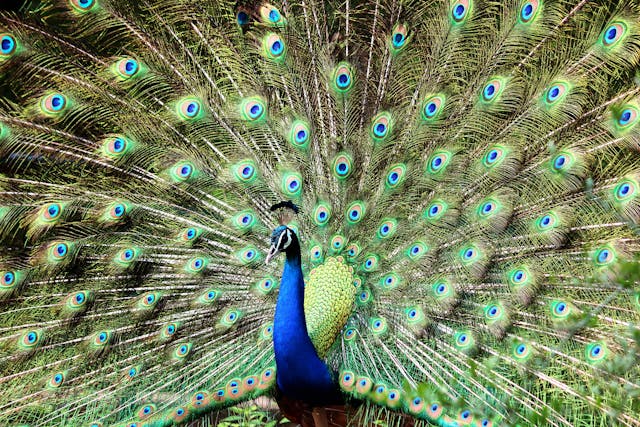
Why do peacocks have such long tails? A peacock’s tail is so long because it confers a large advantage when trying to find a mate.
A peacock’s tail (which is also called a train) is a good example of the balance that means evolution sends a species one way or another. Large tails in peacocks confer an advantage in that they can find a mate and pass on their genes, but if the tail gets too large it will confer more disadvantages than advantages.
The famous tail is only found on the male birds, which are called peacocks. The females are called peahens. Together, the birds are actually called peafowl, although we tend to just refer to them all as peacocks. The males are the ones with the splendid colors and the tails that spring to mind when we think of peacocks. Peahens are browny grey, with a white and black mottled chest. Their heads are brown with white patches on either side. They are perfectly colored to blend into trees or rocks, which is the habitat they live in. Peacocks do not blend in so well. Peacocks obviously vary in size, but their tail tends to be about 1.5 m long. The tail is usually longer than the length of their body. When they are walking or flying, all of the feathers lie loosely on top of each other behind the peacock. It is only when they are courting that they stand the tail feathers up.
Standing the tail feathers up is no mean feat because they are very heavy. Peacocks have a lot of muscle in their back that pulls the tail feather up when contracted. They are able to control these muscles so well that a lot of peacocks vibrate their feathers to make a sound as part of their courting ritual. When they are courting, the male will stand his tail feathers up until a female appears, and then he will move so that the sunlight hits his tail feathers at a roughly 45 degree angle. This makes the tail feathers sparkle the most. The coloring of the tail feathers is not actually a pigment. It is made from microscopic structures inside the feathers that reflect the light in different directions. When the peacocks move their tails, the colors change and shimmer. If the female is still interested in the male after seeing his tale feathers, he starts to vibrate them. This takes an enormous amount of muscle power.
This is where the balance comes in. Peahens are attracted to the peacocks that have larger tails and can vibrate them more vigorously. Being able to grow such a tail and have the muscles to move it shows that the peacock is strong and healthy. It also shows that they can find enough food to feed themselves and they can protect themselves from predators or other peacocks. This strength and health makes them a perfect match for peahens because they want to find the peacock with the best genes, to give their own genes the best chance of survival. This means that the stronger peacocks with the larger tails are more likely to find a mate and more likely to pass their genes on, making it more likely that their offspring will have larger tails. The process will continue because peacocks with smaller tails won’t be able to pass their genes on. However, there has to be a limit. It would be logical to think that the tails would just keep getting bigger and bigger, but there is a point where the size of the tail becomes a disadvantage. If the tail is too big, the peacock needs to find too much food to grow it and to sustain the muscles. The extra tail weight and the extra muscle weight makes it difficult for them to fly and move around, making it harder to find food. The tail size also makes it difficult for them to escape from predators and they are more likely to be eaten. Up to a certain tail size and they have an advantage, beyond that size and it becomes a disadvantage. This is fascinating and you can see it in almost everything. Taller trees get more sunlight, which means they can make more energy, so the trees that are taller than other trees pass on their genes, and trees generally grow taller. However, if a tree is too tall, its trunk becomes unstable, and it is more difficult to get energy up and down its capillary system. Very tall trees are more likely to fall down in a storm and they are less likely to pass on their genes. There is a limit to how tall a tree can be, just like there is a limit to how big a peacock’s tail can be. And this is what I learned today.
Photo by NAUSHIL | SKYHAWK. ASIA: https://www.pexels.com/photo/blue-and-green-peacock-638738/
Sources
https://www.pbs.org/wgbh/evolution/library/01/6/l_016_09.html
https://en.wikipedia.org/wiki/Peafowl
https://pmc.ncbi.nlm.nih.gov/articles/PMC4847759
https://kids.nationalgeographic.com/animals/birds/facts/indian-peafowl

Pingback: #1047 What are tails for?